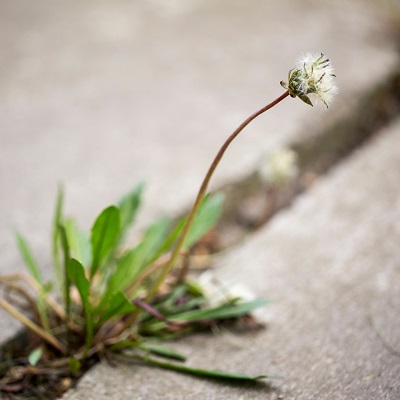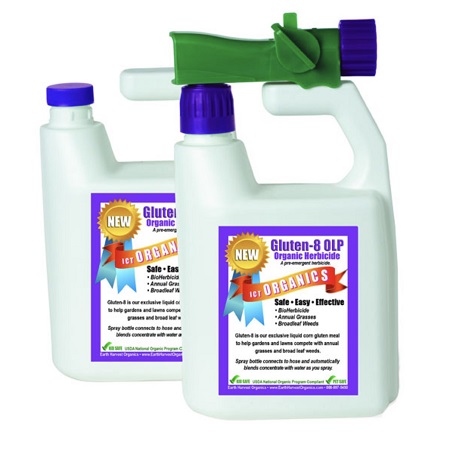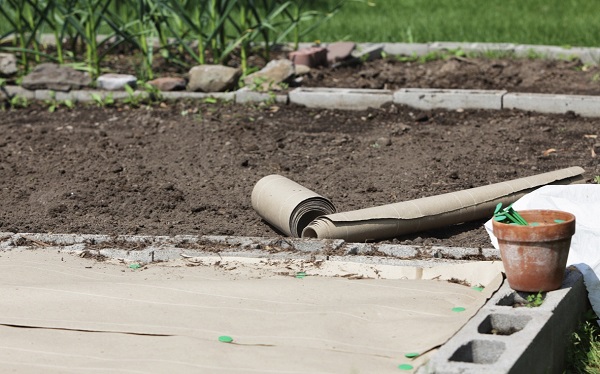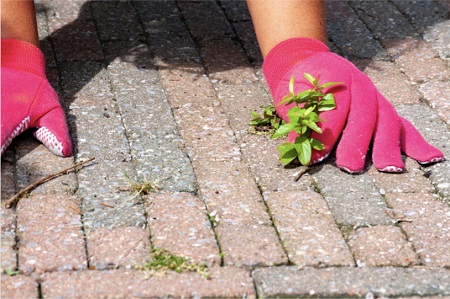
Weed control is a tricky thing to get right. By their nature, weeds pop up where you don’t want them. In fact, the definition of a weed requires that the plant in question must be growing where it is not desired. If the plant is growing in a desired location, it can no longer be considered a weed, even if it is a species of plant that is considered invasive, such as wild violets or dandelions.
While you can certainly go to your local hardware store, head into their garden section, and pick up a big jug of name brand weed killer, many gardeners take the approach that gardening is not simply about eradicating weeds. Instead, the most important approach is be sustainable and do no harm to the environment. Using commercial weed killers composed of harsh chemicals violates this principle, so many environmentally conscious gardeners have turned to organic methods of weed control.
Just because you’ve chosen to stay away from commercial, chemical-intensive herbicides doesn’t mean that you’re waving the white flag and letting weeds overrun your garden or investing countless hours manually pulling up weeds by the root. Many methods of organic weed control are just as effective as chemical sprays, and some methods require only household items. Generally speaking, weed control falls into three stages: Pre-Emergent, Barrier, and Post-Emergent.
Pre-Emergent Care
Oftentimes the best way to take care of a weed infestation is to prevent it from ever occurring. Once a weed takes root, you not only have to find a way to kill it, but you also need to understand that it can scatter seeds that will emerge next year. But we get it. Preventing weeds from entering your garden is easier said than done. Even with proper diligence, weeds will inevitably find their way into your garden. Don’t fret! There are still measures you can take to prevent weeds from overwhelming a garden.

When taking pre-emergent measures, think about what weeds need to take root and grow. They need suitable conditions to root and grow, just like the plants you want to nurture. After establishing your plants at the start of your growing season then verifying that they’ve taken root, turn your attention to ensuring that competing weeds never get the conditions they need to thrive.
Corn gluten is an example of a substance used in pre-emergent weed control. When applied to topsoil, it prevents plants from forming roots after they germinate while not affecting plants with established root systems. Since the weed cannot establish a root system, any shoots will quickly wither and die. However, corn gluten is not a simple, catch-all method of weed control. Timing is critical when applying corn gluten. The soil needs to remain dry after the corn gluten is applied, and corn gluten can also impede the growth of your desired plants if it is applied too early. Corn gluten is available in liquid and granular forms. There’s no need to worry about dangerous chemicals when spreading corn gluten! It’s commonly used in pig feed and is digestible by both humans and common household pets, although it doesn’t taste particularly appetizing.
Focusing your watering also prevents weed growth. Using a sprinkler system spreads water across an entire surface area. Not only is this inefficient, but you’re also making uninhabited soil a perfect place for weed growth. A simple solution would be to manually water your plants using a watering can, but this can quickly become time consuming. We recommend investigating drip irrigation systems to see if this method of water distribution is right for you. Drip irrigation is delivered through underground piping directly into the roots of plants. Not only is this the most efficient way to water plants, but it also has one of the lowest water costs. By only delivering water to plant roots, you prevent weeds from taking over soil frequently moistened by a sprinkler system.

Establishing Barriers
Barriers can be classified as both a means of pre-emergent and post-emergent weed control. By depriving a patch of soil of sunlight, you will prevent any dormant seeds from taking root and kill off any established plants. When most households in America received a daily paper (or at least the Sunday paper), a common gardening tip was to place sheets of your newspaper on an area with weeds (or an area you wished to keep free of weeds). Wet the newspaper to add weight to it, then add a coat of mulch. Any weeds killed off by this method will be broken down by bacteria in the soil and repurposed into nutrients for your plants. Even though you may no longer get a newspaper, rolls of biodegradable garden paper are affordable and serve the same purpose.
Cover crops can be used to form a green barrier. This green barrier serves the same purpose as a barrier created by newspaper or garden paper. By forming a leafy barrier that blocks out sunlight or by competing for the nutrients in the soil, cover crops can prevent weed growth while simultaneously turning a gardening bed into an explosion of green. We recommend planting various types of clovers, as they are hardy, naturally replenish nitrogen in the soil (clovers are a type of legume) and can display a wide variety of flowers. Looking for recommendations on where to start looking? Yellow sweet clover, crimson clover, and hairy vetch all display vibrant flowers while crowding out unwanted weeds. Read this article for more information on how cover crops can help your garden.
Post-Emergent Management

Even with foresight and effort, weeds are still inevitable. You will encounter weeds in your garden, which means you need to have a plan to combat them. There will always be the classic example of putting on a pair of gloves and yanking out a stubborn nettle by the roots. And if you’ve done a good job of establishing pre-emergent weed control, manually yanking out the stragglers may be the simplest option.
Several effective household items that act as weed killers have been passed through gardening circles for many years. Try one of the following options to see what works best for you, but keep in mind that most sprays and formulations are non-selective and should be applied carefully to avoid contact with other plants. You don’t want to go hog wild spraying everywhere and end up accidentally killing your prized petunias!
Vinegar + Dish Soap: This is the time-tested classic. Most household vinegars have 5% acetic acid, but if you have something stronger, it will be more effective. Some gardeners add salt to this mix, but this is largely unnecessary. The dish soap causes the spray to stick to the weed while breaking down the upper epidermis of the leaf. The acetic acid in vinegar draws out the water and dehydrates the weed. Apply to weeds when 24-48 hours of sunny weather is forecasted. Make sure to note that this mixture often fails to kill the root system, which can result in the weed growing back if it recovers from the shock.
Rubbing Alcohol: Start with one quart of water. Add two tablespoons of rubbing alcohol to the water. Repeat these steps until you have enough weedkiller. This mixture mirrors the vinegar solution discussed above, though rubbing alcohol tends to be more potent than a standard cooking vinegar. If needed, you can even substitute vodka for rubbing alcohol—just make sure you’re using vodka from the bottom shelf!
Organic Herbicides: ARBICO Organics specializes in a wide variety of organic herbicides. The Avenger Weed Killer uses a d-Limonene base derived from citrus oil, to dissolve cuticles and dehydrate the plant down to the root system. If you’re looking for a simple, out-of-the-box solution, check it out.
Related Articles & Free Email Newsletter Sign Up
How to Get Started with Organic Gardening in a Greenhouse
Why Green Lacewings Are the Best General Predator for Gardens & Greenhouses


Comment here